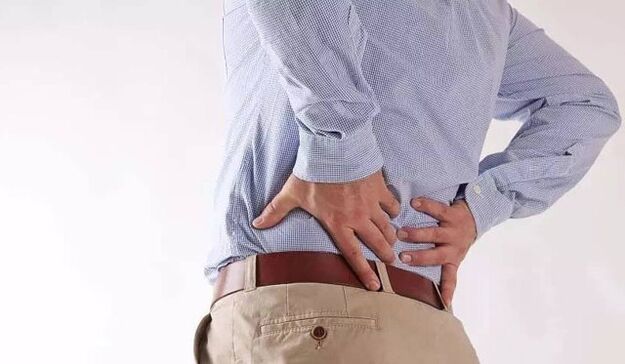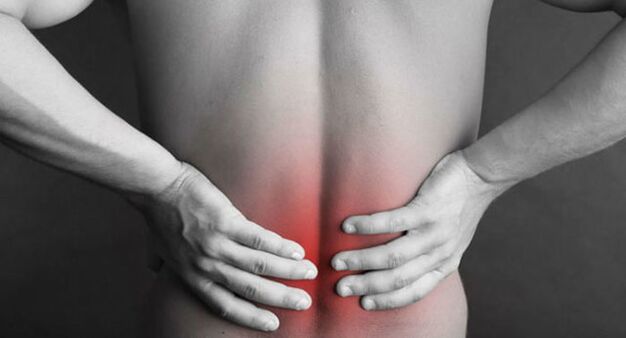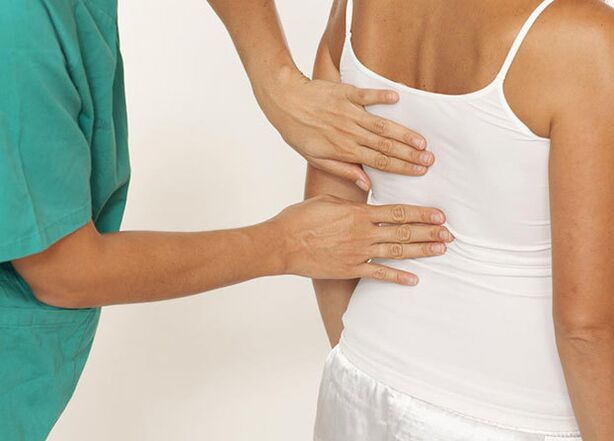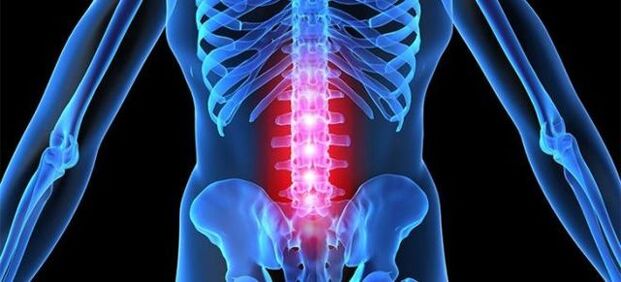About 80% of people over 55 are experiencing manifestations of various back diseases, they should not neglect the faces of the younger age categories. So, one of the most common diseases of the spine-osteochondrosis of the lumbar spine-is also found in patients with 25-45 years. Even young people aged 16-25 are increasingly suffering from symptoms and causes of this extremely unpleasant illness. The question becomes logical about whether it is possible to stop the trend of the number of patients as a whole and what to do to every person for preventative purposes so as not to be a victim of this pathology?

Symptoms
In case of insufficient attention to this disease, untimely diagnosis, its treatment is difficult in that secondary diseases or complications occur. As a natural extension of the pathology, osteochondrosis begins to progress. Its treatment is not always effective and when tightening or improperly prescribed therapeutic course, there is a risk of damage. Another characteristic problem is the appearance of intervertebral hernias, which is accompanied by unbearable painful sensations. Every day, the chances of irrevocable to get rid of hernia become less.
Characteristic clinical symptoms help to recognize the disease in the early stages and to avoid these sad consequences:
- Acute pain after night sleep;
- Pain with acute distributed body or lifting heavy things;
- The body becomes inactive;
- Signs of scoliosis appear;
- Sleep becomes restless;
- Depressive sentiment arises;
- Frequent urination is noticeable.
The independent assessment of these symptoms cannot be correct, as most of them have a common similarity to the signs of other diseases in the spine or joints. Therefore, only a rheumatologist or orthopedist has the competence to speak of the presence of osteochondrosis of the lumbar region.
Classification
Differential diagnosis for proper determination of the disease, distinguishing from identical pathologies and determining the healing course, classification of the stages of this disease helps:
- Stage 1 - At this time the structure of the cartilage is still beginning to change. But now the pathological processes are influenced by the roots of the nerve endings. As a result, pain is applied to the legs. At the same time, the blood flow worsens and inflammation is born. The pain is acute or stupid and occurs mainly only after reinforced loads on the axis of the back;
- The second stage begins with the destruction of the fibrous ring in the spine, while the cartilage is smaller and the vertebrae reduce the distance between each other. The pain in the second stage is acute and acute, sometimes unreasonable. During this period, the mobility of the spine throughout its axis increases, creates a pinch of nerves, creates pressure on the soft tissues of the muscle corset;
- Stage 3 is characterized by strong compression of muscle fibers and nerve roots. Unbearable cramps and burning soreness occur. There is a tingling in the area of the defeat. With the intensive development of the disease, signs of paresis and paralysis appear;
- Stage 4 - the growth period of already formed osteophytes (neoplasms with bone structure). At this stage, changes in degenerative nature are activated, arthrosis in the spine and joints occur. The back becomes inactive and in the absence of proper treatment - completely stationary.
Diagnostic methods
Since Even the Ideal Knowledge of the Clinic and the Classification of Osteochondrosis of the Lumbar Spine Doses Not Give a Complete Idea of the Pathological Process Provised by Him, A DOCTOR WHOProcesses in the Spine, Ailments of the Musculoskeletal System Or the Orthopedist has to Be Prescribed An Additional Diagnostic Examination:
- X -Ray in the frontal and lateral projection - allows to identify the curvature of the axis, the formation of osteophytes, anatomical abnormalities of the vertebrae;
- Magnetic resonance determines the condition of the entire back area of the back, detects fragments of destroyed vertebrae, cartilage and foci of inflammation;
- Computed tomography gives an idea of the condition of the soft tissues, the bones of the vertebrae, the outer sheath of the intervertebral disc, in principle, which is in principle for its integrity. and circulation in the area of the location of the disease.

At the same time, the patient tests for rheumatoid test, common blood indicators, the content of biochemical components. The general results of the study allow you to accurately establish the diagnosis and identify the stage of development of osteochondrosis of the lumbar region.
Symptoms and treatment of osteochondrosis of the lumbar spine
Among the common causes of back pain, osteochondrosis of the lumbar spine, the symptoms whose treatment has their characteristic characteristics. The disease is the initial stage of osteochondrosis associated with the process of destruction of the cartilage ring, the intervertebral discs, the change in their height to reduce, the formation of swelling and the tongs of the nerve roots. Young and elderly people can face the disease, regardless of gender, social status and religion. The long absence of the symptoms of the disease leads to a loss of valuable time and a transition from one stage of the disease to the more severe forms of its development. The main distinguishing characteristic of osteochondrosis is the border area of dystrophic changes in the tissues of the vertebrae, which does not exceed the articular cartilage.
Causes of the initial stage of osteochondrosis
A number of external and internal factors determine the development of the pathological condition of the lumbar region of the axial skeleton. Lumbar osteochondrosis occurs due to certain risk factors. These include:
- aging of the body after 50 years;
- Improper posture and abnormality of the anatomical structure of the axial skeleton, which determines the uneven load of the vertebrae;
- lifting weights with a weak muscle frame;
- hypothermia of the patient's body as a whole and lower back separately;
- dysfunction of metabolic processes, work of endocrine organs, cardiovascular system;
- uneven loads of the spine during the performance of production obligations, household affairs, professional and amateur sports;
- pathologies of the musculoskeletal system with congenital or acquired nature;
- Hypodynamia, high incidence of stress;
- excess patient weight;
- lack of vitamins, minerals, tracking of elements in the body of a sick person who are responsible for the health of the spine;
- Acquisition of high collection shoes, uncomfortable platforms;
- The use of tall pillows and soft mattresses during rest and sleep.
The incidence of diagnosis of lumbar skeleton osteochondrosis is determined by the number of risk factors for its development that are present in the patient's life.
Diagnosis
Determining the degenerative dystrophic lesion of one of the five vertebrae of the lumbar space of the axial skeleton provides diagnostic measures. They are prescribed by a doctor. Consultation with a specialist who knows how to treat lumbar osteochondrosis, a history of the disease is collected, the time and the characteristics of the signs are clarified the intensity and place of localization of painful sensations. The condition of the muscle fibers in the area of damage is determined by visual examination. The use of the palpation method enables a doctor to see a photo of the vertebrae symmetry and the distance between them. The final diagnosis is established after receiving the results of additional studies. These include:

- X -Ray, carried out in two projections and giving the opportunity to see the position of the vertebrae, the height of the discs, the seal of the limit bone slabs and outgrowths;
- Magnetic resonance imaging, which is a special method of examination to determine the condition of the vascular system and fibrous rings in the degenerative dystrophic lesion of the area.
The goals and methods of treating pathology
The results of the diagnostic measures are the basis for the treatment regimen for osteochondrosis of the lumbar lumbar skeleton that pursues certain goals. These include:
- reducing the intensity of pain caused by degenerative-dystrophic lesions of one or more vertebrae of the lumbar skeleton;
- Normalizing the metabolic processes in cartilage, their restoration and exclusion of the risk of their more destruction;
- Reducing the load on nerve fibers;
- Increased blood flow to the tissues of the spine, using massage, physiotherapy procedures;
- Strengthening the muscle frame of the axial skeleton through regular exercises for exercise recommended by the instructor.
Therapy of chondrosis of the lumbar spine, the symptoms and treatment of which have their own characteristics, consist of taking and using pharmaceuticals, recipes for traditional medicine, methods of non -traditional treatment, including surgery therapy. Effective addition to solving the problem of pathology is physiotherapy, water, massage procedures, gymnastics and sports, including special exercises. Drug therapy includes the use of anti -inflammatory non -steroidal drugs, muscle relaxants, chondroprotectors, vitamin complexes with trace elements and minerals.
Very severe pain prescribes the blockades of novocaine or lidocaine, performed by introducing injections into the affected vertebrae areas. For topical use, ointments, gels, creams, patches with warming, anti -inflammatory effect are prescribed. Physiotherapy treatment involves the passage of healing courses of electrophoresis, diadynamic currents, exposure to ultravioletus, manual, shock wave and reflexology. In the absence of positive dynamics, the appearance of hernial protrusions is prescribed, surgery is prescribed. In order to avoid the development of complications with the onset of the first symptoms, treatment should be started immediately.
Lumbar osteochondrosis
Lumbar osteochondrosis is one of the most common forms of the underlying disease, in fact osteochondrosis. Lumbar osteochondrosis, the symptoms of which are determined equally by both men and women manifested in the form of pain concentrated in the area of the sacrum, reflected in their symptoms and on the lower limbs, which is often defined by patients as "pinching the lumbar nerve".
Bulge for lumbar osteochondrosis
Dentures in this area of interest for us develop most often, in addition, the protrusion causes the onset of lower back pain. The lumbar region itself, given its location and characteristics, is the most subject to the emergence of certain functional problems. That is, when we look at this claim, on the one hand, it can be distinguished that our center of gravity directly refers to the lumbar department, it is a significant part of the load on it. When considered, on the other hand, it can be noted that a significant amplitude of movements again falls on this lumbar region. Given this, the largest tendency to damage (as well as projections of interest to us) is on the discs concentrated in the lumbar region. In addition, we should not forget that changes in the discs in this and, of course, in other areas, occur, including against the background of age degenerative processes.
Remember our readers what the projections themselves are. The connection of the discs in the spine is provided by the wheels based on cartilage. The main components of the intervertebral disc are the core of the port and a fibrous ring, which ensures fixation within the spinal disc. The impact of certain factors and conditions provokes the possibility of breaking down this ring, against which the convexity of the nucleus arises. As a result of this process, hernia develops. As for the convexity, it already develops as a result of a similar course of the process, but without the concomitant rupture of the ring - in this case it simply is subject to thinning rather than resting, because the core protrudes directly through the ring. In fact, this convexity is defined as a convexity.
As for the symptoms of convexity, it manifests itself as follows:
- feeling of stiffness in the lower back;
- soreness in the lumbar region;
- Lower pain of chronic nature;
- lumbosacral radiculitis;
- numbness, pain, tingling of the toes, in the legs;
- Impaired function of urination (in rare cases of pathology in question).

The most conservative treatment is applied to the bulge of the lumbar disk. Meanwhile, significant in the development of protrusion are often accompanied by severe symptoms, resistant to treatment, in which case you can no longer do without surgery.
Treatment
Most of all, the treatment of osteochondrosis is multicomponent and is quite complicated in its implementation. Most of all, all therapy measures are reduced to the following points:
- treatment with drugs;
- If necessary - surgical treatment;
- diet;
- Medical physical education.
The exacerbation of the disease requires, first and foremost, observing the bed rest for patients. The main recommendation for this part is a difficult/difficult place to sleep. Extremely pronounced in manifestations, attacks ensure the need for minimal engine load and early contact with the specialist.






















